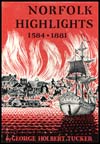Chapter 47
The Hanging of Dr. Wright
The hanging of Dr. David Minton Wright for the murder of Federal Lieutenant A.L. Sanborn was a grisly highlight of the Norfolk Civil War period.
Born in 1812 in Nansemond County, Dr. Wright moved to Norfolk in 1853 from Edenton, N.C., where he had married Miss Penelope Creecy. In 1855, when the Norfolk area was prostrated by the worst yellow fever epidemic in its history, Dr. Wright was stricken. He recovered, however, and his unselfish attentions to the sick and dying of his adopted city won him the respect of everyone.
Although a Southerner, Dr. Wright was a Unionist and opposed Virginia's secession from the Union. Once that took place, he remained in Norfolk.
On June 17, 1863, a little over a year after Norfolk was retaken by the Federal forces, Dr. Wright was walking west on Main Street from a celebration of his wedding anniversary. Arriving at Church and Main streets, he met a column of black Federal soldiers under the command of a white lieutenant, A. L. Sanborn.
Resentment in Norfolk was then running high against the presence of black troops, and as Dr. Wright shared that feeling, he approached Sanborn with clenched fists, saying, "Oh! You coward!"
Sanborn halted his troops, turned to Wright, and said, "You are under arrest." At that point the soldiers moved in to apprehend him. Maddened at the thought of being seized by the black soldiers, the doctor did a rash thing, two versions of which have been reported. One says he pulled a pistol from an inner coat pocket and fired twice at Sanborn. The other says the pistol was handed to him by a spectator. Be that as it may, Sanborn was wounded, staggered into Foster & Moore's Drug Store, and died, after which Wright was arrested and charged with murder.
During his trial, his admirers stood outside the courtroom and lifted their hats silently as he hobbled in and out, his wrists and ankles heavily chained.
Wright was found guilty and was sentenced to be hanged, a verdict that Norfolk people resented as they regarded him as a martyr to the Southern cause. Powerful influences were brought to bear to save his life, but all of them failed.
In the meantime the doctor's daughter, Penelope, decided to do something to save her father. Visiting him in his dimly lighted cell, she exchanged her outer clothing with him, slipped on his boots, and crept under the blankets of his cot. The doctor then walked out of his cell and had gone fifty yards from the door of the prison to a waiting carriage when a sharp-eyed sentry called attention to his unusual height and masculine gait. Wright was then recaptured, but his daughter was not detained or molested.
As the time for the execution drew near, President Lincoln granted a week's reprieve in order to give the case more study, but in the end he refused to intervene.
Wright was taken to the scaffold set up in the center of a racetrack on the outskirts of the city on October 23, 1863, between long columns of troops, while the sound of wailing was heard from shuttered houses all along the way. Troops were posted in a square around the gallows, while thousands of spectators looked on from rooftops or stood on tiptoe in wagons, carts, and buggies.
Wright had made his own coffin of cypress wood while he was in prison, and after his body had been turned over to his family, it was placed in it and taken to Old Christ Church for the funeral. Inside the lid of the coffin were pictures of the doctor's wife and children, one of them his oldest son, who had been killed three months earlier in the Battle of Gettysburg.
But the doctor never knew that his son had died for the cause that he had disapproved of at the beginning of the war. When the news of the young man's death was learned, the family spared him and never told him the sad news.
Chapter
48
A Norfolk Girl Told President Davis
Norfolk Highlights 1584 - 1881

See the "Table of Contents" for links to every chapter in Norfolk Highlights 1584 - 1881 by George Holbert Tucker.
